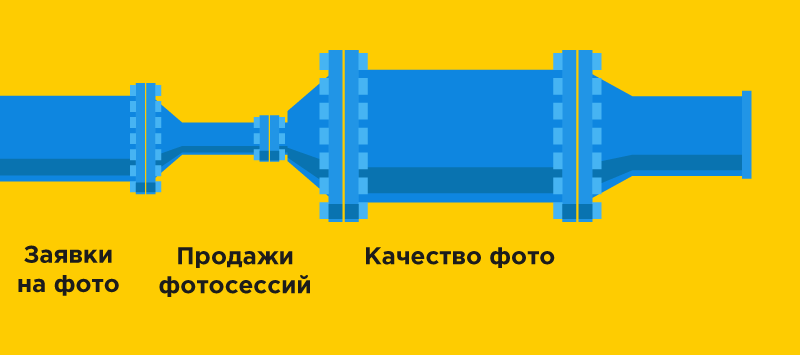How the theory of restrictions helps to earn more - personal experience Logoshin

Abstract question: Imagine that you spend the water to the next village after a couple of kilometers. You made up your water supply system from pipe sections, and each section has its own diameter - some pipes are a couple of centimeters thick, others were found wider, half a meter in diameter. How well will such a water supply system work? Will its throughput be equal to the average pipe diameter?
The Goal book by Eliyahu Goldratt suggests that the carrying capacity of such a pipe system will tend to the capacity of the narrowest point. In other words, you could not search for pipes wider - if the system has a section with a diameter of 2 cm, the entire water supply system will work like a 2 cm pipe.
')
How does this principle help earn more? I'll tell you now.
The principles of Goldratt are united in the " Theory of Constraints ". The beauty is that it applies to almost any system.
For example, we lead a column of children in a campaign. What does the theory of restrictions say? No matter how quickly individual children could walk, the entire column would move at the speed of the slowest child. Those who go faster, will do extra work - to run ahead, and then wait for the rest. What can be done with this?
In his book, Goldratt examines this example - first he put the slowest child, “fat Henry,” in front of the column. This did not accelerate her, but made it clear to everyone that the column would not go faster than Henry. Goldratt calls this restriction the “ bottleneck ” of the system or the bottleneck . How to speed up the column?

To make the column go faster, you need to “expand the bottleneck” - to accelerate Henry. In the book, the guys guessed to take out heavy things from Henry's backpack and distribute them among themselves. Henry went faster and the whole column reached the halt on time. Pay attention - for the whole "system" there was no point in investing power in anything other than accelerating Henry.
This is one of the main thoughts of the book - only investments in a bottleneck will give a multiple increase in productivity. How does this help earn more?
Theory of limitations in life
For example, consider any employee or freelancer.
For example, photographer Andrew fotkaet portraits for 3,000 rubles per hour. He really wants to earn 4,000 rubles, but he believes that the quality of the photos so far only draws on three. Of course, in fact, he wants more customers and more expensive orders, but so far he can only count on moving from 3,000 per hour to 4,000.
Andrei went to a couple of courses on photography, bought a soft box, a new lens and finally decided to raise the price. Some clients fell off, but in general, Andrew began to earn a little more. Why a little?
Let's look at the photos that Andrew made for 3,000 and for 4,000 rubles:

Over 4,000 left.
Or to the right ...
Do you see a difference of 1,000 rubles? Me neither. And Andrey's clients do not see - someone likes the photo on the right, someone on the left. Why did he put so much on the quality of the photo, which no one can really appreciate? The thing is that Andrew fell into the trap of a professional .
Professional trap
Andrei, like many other professionals, invests most of his energy and resources in becoming a better photographer: he goes to the courses, buys new equipment, studies technologies and methods.
At first, it really gives off fruit: the first clients appear, it is not a shame to take a couple of thousand for shooting. Professional photographers are beginning to praise. But years later, Andrei’s photo equipment already costs hundreds of thousands, and buying a new lens does not make it possible to earn much more. If we apply the theory of constraints, Andrei’s “system” looks like this:

Many customers come to Andrey, and he buys little. There are no complaints about the quality of the photo.
Andrei thinks that his quality is not cool enough to earn more, but in fact it is limited by another thing - his ability to communicate with people. Many are interested in his services, but Andrew is unfriendly, does not like and does not know how to negotiate. Many are willing to pay more for such quality, but the service disappoints them. This is his bottleneck .
Therefore, every ruble invested in negotiating and sales skills will bring Andrei much more orders than buying the next lens. Customers simply can not distinguish the quality of images on the old and the new lens - they are not such professionals as Andrew. But the fact that he reluctantly speaks on the phone and forgets to call back, makes a bad impression.
Why does Andrew, and most professionals fall into such a trap? When you spent years on the hairdresser's art, and now you can distinguish the most up-to-date haircut from the simply modern one, you begin to cut extremely super-modern. And the professional community does not sleep - all 10 haircut gurus are watching your work. And let customers do not appreciate it, but their colleagues will put "Like". All the professionals sooner or later begin to understand their work so well that their progress can be assessed only by the same professionals.
The theory of constraints does not mean that you can stop doing qualitatively. It is important to look for the bottleneck of the system - then punctuality, and terms, and the ability to communicate will fall into the concept of “quality”.
This applies to hired work. Perhaps, as a specialist, you could receive much more, but you are constantly late. Or miss the timing of timing. Or maybe you will earn at times more in another area - now this is your bottleneck. It is important to find a limit and throw all the forces on its expansion.
Theory of business restrictions
Business is always a system. Therefore, I apply the theory of constraints in my project.
One of the “pipe” sections in the Logomachine looks like this: visitors leave a request for a design on the website, the manager answers questions and issues invoices, the art director checks the brief form and asks for clarification. There are a lot of applications from the site, the art director can brief more. But sales turned out to be our bottleneck:

To understand why we sell less than we could, we looked at this “pipe section” separately. All applications from the site fall into the amo-crm funnel:

This is a fresh screenshot, and when we looked at the funnel for the first time, most of the applications accumulated at the under-call stage. It was a bottleneck inside a bottleneck! Problems at the sales site were due to the fact that the manager did not dial in half of the cases, and then he did not have time to call.
And this trifle limited the work of the entire system. The art director could brief more clients, designers are able to do more corporate identity and animation, personal managers can lead more clients. But the whole system was hampered by the fact that the manager did not always dial up to those who left the application. It was the "fat Henry" of the Log Machine!
What we did to expand this bottleneck:
- They got an additional mobile number - not all customers want to raise 8,800, who knows what the company calls them?
- Allocated sales to a separate entity - before the manager did a lot of work in addition to calls
- At first, two marketing workers helped the manager to call back (and even made several sales)
All this not only cleared the traffic jam on the status of "under-calling", but also increased the monthly revenue by almost half. This proves once again that the expansion of the bottleneck affects the operation of the entire system.
Now the Logoshin bottleneck has moved to the marketing area - now the manager can process more applications than before.
Total
At first I did not take the theory of constraints seriously. Now I understand: it helps to prioritize and achieve results with pinpoint efforts.
If earlier I wanted to make the site more abruptly, and buy ads, now I understand - we must look for the bottleneck of the entire system and invest most of the effort there. There may be several of them, and when expanding, other areas become narrow places.
This theory is applicable not only to business: often punctuality, confidence, communication skills, or public speaking become a personal limitation.
PS As an example, I will give a funny story from one entertainment site - I think you will understand what the theory of restrictions is about:
I had to somehow meet and later work with the boy Sasha. Even before meeting with him, a girlfriend with terrible eyes told that Sasha is very shy, unsociable, she does not communicate with her incomplete 30 girls, as she has a “terrible flaw” in the form of a scar on half of her face. Burn from childhood. He lives with his mother and her ten cats.
And now the hour has struck, Sasha comes in: beautiful, tall, with a figure and with the cutest shy smile that I have ever seen. Later it turned out that he was also smart, well-read, and in general in my eyes the scar disappeared a long time ago under the pressure of exceptional human qualities. However, we did not go further than friendship. In a burst of revelation (thanks to half a bottle of brandy) Sasha confessed to me that he hates himself, his scar, that this is because of the scar of his girlfriend, but he so wants a family.
And then, strangling shyness and awkwardness, I admitted that it was not at all a scar matter.
"Just from you, Sanya, a kilometer cat urine." She said and calmed down, I think, now I have lost a friend. But no, it's all right! He neighing, appreciated the "joke." And so seriously to me - “Thank you, of course, for amusing me, but I know that this is all a scar ...”
Source: https://habr.com/ru/post/344796/
All Articles